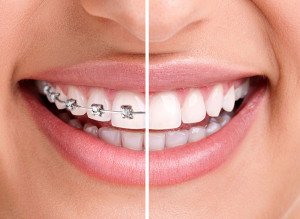Orthodontia, also known as orthodontics and dentofacial orthopedics, was the first specialty created in the field of dentistry. An orthodontist is a specialist who has undergone special training in a dental school or college after he/she has graduated in dentistry.
Invisalign
[vc_single_image image=”602″ img_size=”full” alignment=”center” style=”vc_box_rounded”]
What is Invisalign?
Invisalign is an orthodontic treatment option that allows doctors to straighten teeth using a series of clear, removable, nearly invisible, plastic appliances called aligners.
How does Invisalign work?
The patient meets with an Invisalign-certified dentist or orthodontist who takes orthodontic records of the patient’s teeth, including impressions, and fills out an Invisalign treatment planning or prescription form and sends all the material to Align Technology.
At Align, a computer model of the patient’s teeth is created from the impressions. Align then uses its advanced, 3-D imaging software to generate a graphical representation of the doctor’s treatment plan—almost like an animated movie of the way the patient’s teeth will move from the current position to the final desired position.
The doctor reviews and approves the rendering of his treatment plan (the 3-D movie) on a secure portion of Align’s website. Align Technology produces a series of clear, plastic aligners that correspond to the stages of tooth movement in the 3-D movie.
The patient wears each stage of aligners for approximately two weeks before switching to the next set in the series. Week by week, the patient’s teeth are straightened millimeter by millimeter.
Is this a new way to straighten teeth?
Doctors have successfully used removable appliances for years for very limited treatment. With the application of 3-D computer technology and mass customization, Invisalign can be used to treat almost anyone who wants straighter teeth.
Benefits of Invisalign
• Nearly Invisible: You can straighten your teeth without anyone knowing
• Removable: You can eat and drink what you want
• Better Oral Hygiene: You can brush and floss normally to maintain healthy gums and teeth
• Comfortable: There are no wires, metal or brackets to cause mouth abrasion
Who can benefit from Invisalign?
Experienced doctors can use Invisalign to treat the vast majority of people who want straighter teeth. The only criterion is that the patient must have their second molars. According to the Journal of the American Dental Association, two-thirds to three-fourths of American adults (between 136 and 154 million) have some sort of malocclusion (crooked teeth) and could benefit from orthodontic treatment.
How long does treatment take?
Like traditional braces, the length of treatment depends on the complexity of the case. Treatment time is about the same as conventional braces—about a year.
Can any doctor treat patients with Invisalign?
Doctors must attend and complete an Invisalign certification seminar to treat patients with Invisalign. To date, more than 70 percent of orthodontists in North American have become Invisalign-certified, and Align is currently certifying general practitioner dentists. Align also provides doctors with many opportunities for continuing education and advanced Invisalign training.
How much does Invisalign cost?
Invisalign is priced by the treating doctor, not by Align. Several factors impact cost of treatment, such as complexity of the case, market price within the patient’s geographic area, etc. An Align survey of certified doctors across the country indicates that average fees for Invisalign range from $3500–$5500.
Does insurance cover Invisalign?
Typically, an insurance policy that covers traditional braces also covers Invisalign to the same extent. In addition, many doctors offer financing through companies such as CareCredit® as well as in-office financing.
How many people are in treatment with the Invisalign System?
More than 230,000 patients have entered treatment with Invisalign.
Read more: Why Invisalign in Dubai is too Popular?
Inman Aligners
[vc_single_image image=”603″ img_size=”full” alignment=”center” style=”vc_box_rounded”]
What is it?
Inman Aligners are an alternative technique to straighten your front teeth, top or bottom. It is a removable appliance, worn at least 20 hours per day, that is minimally visible. Inman Aligners can be used as primary treatment, or a precurser to veneers or other cosmetic treatments. It is ideal treatment to correct preovious orthodontic relapse malalignment. It is the perfect solution for crowding, protrusion or retrusion of front teeth.
How does it work?
Inman Aligners consist of two Nickle Titanium coil springs that power two aligner bows that gently oppose each other, moving your teeth into the correct alignment. These gentle forces are active over a very large range of movement, which allows the treatment to be completed quite quickl.
How long does it take?
The average course of treatment for Inman Aligners takes 6 to 18 weeks. Come in for a consultation for a realistic time frame for you!
Why should I use Inman Aligners?
Straightening your front teeth is beneficial to not only aesthetics, but also your long term oral health. Uneven teeth are prone to wear and abrasion, and as a result, staining. Straight teeth are far less likely to suffer the aging process that crowded or misaligned teeth will.
Read more: Inman Aligner in Dubai
Ceramic Braces
[vc_single_image image=”1209″ img_size=”full” alignment=”center” style=”vc_box_rounded”]
Ceramic braces are the same size and shape as metal braces, except that they have tooth-colored or clear brackets that blend in to teeth. Some even use tooth-colored wires to be even less noticeable. They can easily change your smile within six months. After fittings, you will need to go for regular check-ups so as to make sure the braces are well placed as well as adjust your wires. The treatment often takes 1-2 years after which you will be fitted with a retainer that is properly aligned with the new positioning of your teeth.
Metal Braces
[vc_single_image image=”1207″ img_size=”full” alignment=”center” style=”vc_box_rounded”]
These are the metal brackets and wires that most people picture when they hear the word “braces.” However, modern brackets are smaller and less noticeable than the notorious “metal-mouth” braces that many adults remember. Plus, new heat-activated arch wires use your body heat to help teeth move more quickly and less painfully than in the past.

